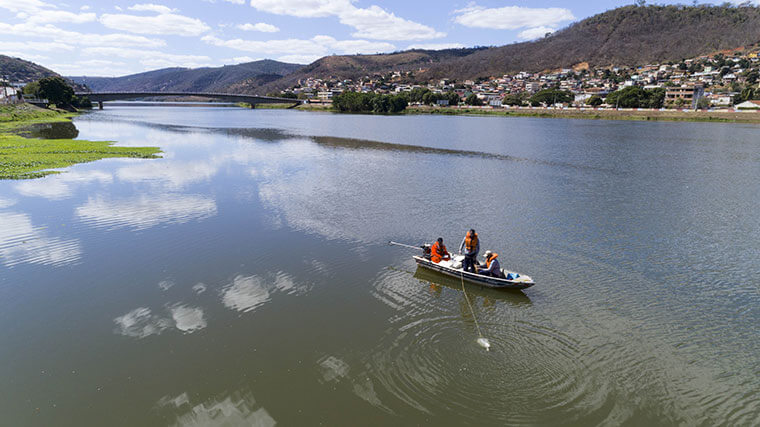Study of the Minas Gerais Institute of Water Management compares historical data series between the first year after the collapse and the second year, until August 2017
For more than 20 years, the Minas Gerais Water Management Institute (Igam) has verified the water quality of the Doce River, but with the Fundao dam collapse, this monitoring has gained invaluable importance. Since November 7, 2017, Igam has intensified the sample collection at 12 points of the Doce River channel. In the Carmo River and Gualaxo do Norte River, monitoring began at the end of November.

Today, the Renova Foundation monitors 92 points along the Doce River and coastal zone. | Photo: Gustavo Baxter / Nitro Imagens
The water of the rivers is evaluated by means of 18 parameters:
- electrical conductivity in loco;
- dissolved oxygen;
- pH in loco;
- temperature;
- total solids;
- total dissolved solids;
- total suspended solids;
- turbidity;
- total arsenic;
- dissolved aluminum;
- dissolved iron;
- dissolved copper;
- total chromium;
- total cadmium;
- total lead;
- total manganese;
- total mercury;
- total nickel
The Institute now launches a study on this monitoring with a comparative of the historical series data, the first post-collapse year and the second year, until August 2017. The reduction of the indices analyzed is remarkable when compared to the first monitoring period. “Two years after the collapse of the Fundao dam in Mariana, it was possible to verify the general behavior of the affected area in relation to the pollutants considered most important. Compared to the first year of analysis, from November 2015 to November 2016, it was observed that there was a large reduction in the average of the results in the second period for most of the evaluated parameters, indicating a trend of getting closer the historical values observed in the monitoring of Igam, however, still with a large proportion is violating the limits established in the Joint Legislative Deliberation of the State Environmental Policy Council (Copam) and State Council of Water Resources (CERH) n 01 of 2008,” said the water quality monitoring manager of Igam, Katiane Brito.
Despite the significant reduction, or improvement in water quality, in the last analyzed interval, from November 2016 to August 2017, with respect to the parameters turbidity, suspended solids, dissolved iron, total manganese and dissolved aluminum, the averages are still above the legal limit and historical averages. “These results can be attributed to the accumulation of tailings in the river bed and in the banks, that continue to be stirred up,” said Igam environmental analyst Regina Pimenta.
In the case of arsenic and other metals in the total form (cadmium, chromium, nickel, mercury and zinc), similar behavior occurred in the second period, always below legal limits and close to the historical average. Both the total lead and the dissolved copper were above the historical averages in the first analysis. Now, these values are already less than or equal to the average and below the legal limit.
If we compare the data, we can see a reduction in the averages of the results in the majority of the evaluated parameters. This indicates a trend towards getting closer to the historical values monitored by Igam, but still violating the legal limits.
Water quality
The monitoring of water quality performed by Igam is done using water that comes directly from the river. The results reinforce the need for conventional treatment to supply and evaluate the Municipal Health Secretariats for recreational uses such as: swimming, water skiing and diving, irrigation of vegetables, fruit plants and parks, gardens, sports and leisure fields, with which the public can come into direct contact.
The Doce River water quality monitoring, focusing on the evaluation of recovery after the disaster, will continue to be carried out by the Renova Foundation, through a network composed of 92 monitoring stations, among which, 56 conventional quality monitoring along of the rivers and lagoons, with 22 automatic stations and 36 points in the coastal zone that are part of the Qualitative Quantitative Systematic Monitoring Program (PMQQS).
Click here to access the full Study (available in Portuguese).
